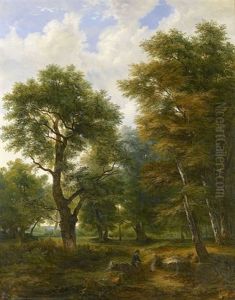Emile Cesar Victor Perrin Paintings
Emile César Victor Perrin, born on April 27, 1814, in Paris, France, was a distinguished French painter, primarily recognized for his contributions to theater and decorative arts. He was part of the Romantic movement that swept through French art and culture in the early 19th century. Perrin's artistic talents were not confined to the canvas; he was also an influential administrator in the French art world.
Educated at the prestigious École des Beaux-Arts in Paris, Perrin studied under influential painters such as François-Édouard Picot and Léon Cogniet. He exhibited his work at the Paris Salon, the official art exhibition of the Académie des Beaux-Arts in Paris, where he received recognition and accolades for his contributions to art.
Perrin's career was not limited to painting. He became an important theater administrator, serving as the director of the Théâtre-Lyrique and later as the administrator of the Comédie-Française, a state theater considered the world's oldest active theater company. His involvement in the theater influenced his work, as he often painted scenes with dramatic lighting and staging.
Throughout his lifetime, Perrin held various prestigious positions, including the directorship of the French Academy in Rome from 1872 to 1876. This role allowed him to influence and support the development of young artists studying in Italy. In 1876, he was appointed as the director of the École des Beaux-Arts, a position he held until 1881. His administrative roles were a testament to his commitment to nurturing the arts in France.
As an artist, Perrin was known for his historical and genre paintings, which often depicted scenes from theater and French history. His style was characterized by rich coloration and careful attention to detail, hallmarks of the Romantic aesthetic that sought to evoke emotion and grandeur.
Perrin was also recognized by the French government for his contributions to art and culture. He was awarded the Legion of Honor, France's highest order of merit for military and civil merits, and he was promoted to the rank of Commander in the order.
Emile César Victor Perrin passed away on March 11, 1905, leaving behind a legacy as both an artist and an influential cultural administrator. His work continues to be studied by art historians and is part of collections in museums throughout France, offering insight into the Romantic era and the convergence of visual arts and theater during the 19th century.


